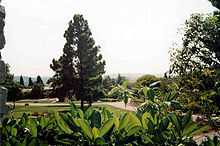Ramot Menashe
- For the geographical region, see Plain of Manasseh.
| Ramot Menashe | |
|---|---|
 Ramot Menashe | |
| Coordinates: 32°35′48.11″N 35°3′25.92″E / 32.5966972°N 35.0572000°ECoordinates: 32°35′48.11″N 35°3′25.92″E / 32.5966972°N 35.0572000°E | |
| Council | Megiddo |
| Region | Menashe plateau |
| Affiliation | Kibbutz Movement |
| Founded | 1948 |
| Founded by | Polish immigrants |
| Website | Ramot Menashe |


Ramot Menashe (Hebrew: רָמוֹת מְנַשֶּׁה, lit. Menashe Heights) is a kibbutz in northern Israel. Located on the Menashe plateau between the Carmel mountain range and the Jezreel Valley, it falls under the jurisdiction of Megiddo Regional Council. In 2011 it had a population of 1,013 and in that year it became a UNESCO Biosphere Reserve.[1]
History
Ramot Menashe was established in July 1948 by immigrants from Poland [2] many of whom were Holocaust survivors who had participated in ghetto uprisings against the Nazis. Throughout its existence Ramot Menashe has absorbed members from various countries such as Chile, Uruguay, Argentina, Brazil, Cuba and Israel who like its original founders, were members of the socialist Zionist movement Hashomer Hatzair.
In the 1990s Ramot Menashe underwent a process of privatization, also known as 'The Change' following the kibbutz crisis, and in 2007 it began absorbing 138 new families as part of its expansion project.
According to Israeli historian Benny Morris,[3] the kibbutz is located on land close to Daliyat al-Rawha', a depopulated Arab village, while Palestinian historian Walid Khalidi notes that the land of Ramot Menashe actually belonged to the former village of Sabbarin.[4]
Economy
The most important sources of income for the kibbutz are the production of water meters (which are manufactured in co-operation with neighbouring kibbutz Dalia), micro-encapsulated products, various crops such as mango and avocado, as well as poultry and dairy farming.
Numerous facilities are available to the inhabitants of the kibbutz, including the communal dining hall, children's daycare, a laundry service, a shop stocking day-to-day necessities, a swimming pool, a clinic, a dentist, an archaeological museum, a post office, a café and a clubhouse, as well as films and shows at the regional hall adjacent to kibbutz Ein HaShofet.
Ramot Menashe's popular nightclub Terminal was recently closed.
References
- ↑ "UNESCO Biosphere".
- ↑ Vered, Abraham & Porat, Lynne (2012). Ramot Menashe: Memories from the First Decade. Charleston, SC: Create Space.
- ↑ Morris, Benny (2004). The Birth of the Palestinian Refugee Problem Revisited. Cambridge: Cambridge University Press. p. xx.
- ↑ Khalidi, Walid (1992). All That Remains: The Palestinian Villages Occupied and Depopulated by Israel in 1948, Washington D.C.: Institute for Palestine Studies. pp. 158, 187.
External links
- Kibbutz website (Hebrew)
- Kibbutz on municipality website (Hebrew)
| ||||||||||||||||||